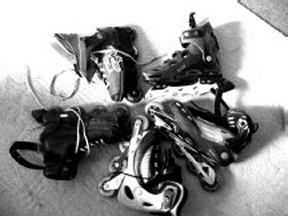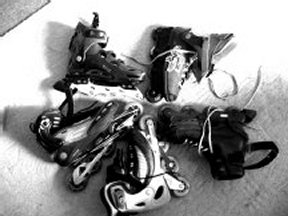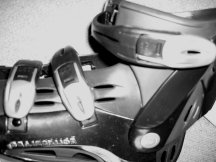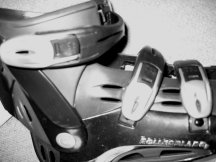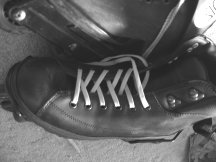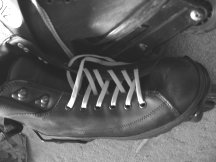|
How To Choose A Pair Of Skates - What Do I Buy? |
||||||||||||||||||||||||||||||||||||||||||||||||||||||||||
|
|
||||||||||||||||||||||||||||||||||||||||||||||||||||||||||
|
||||||||||||||||||||||||||||||||||||||||||||||||||||||||||
|
|
||||||||||||||||||||||||||||||||||||||||||||||||||||||||||
|
The Selection Process If the skate does not fit you comfortably then you won't wear it. If it doesn't support you properly, you could become injured or have problems skating. Take time when selecting you new skates. I tell people to plan to spend an afternoon in the skate shop trying on skates. Once you have gone through your check list of important items, you need to put the skates on and stand or wander the store (carefully) in them for at least a half hour. If after a half hour your feet still feel cozy inside, there are no sore spots, pinching or poky things bothering your feet, you're probably good to go. Next is the confusing part, what brand to I buy? What is the difference between brands and styles? Often you can answer these questions by taking a look at your goals as a skater. Are you wanting to buy skates for fitness purposes? Are you interested in playing inline hockey? Are you a new skater or do you have years of experience on skates? If you are an experienced skater you probably know exactly what you want in a skate, if you are new to skating it becomes more difficult to determine your goal. Search online and learn about skates, Find a Inline Skate shop in your area and talk to a knowledgeable sales person. If there is a shop that rents skates and gear, you are in luck. Rent several different pairs, gear up and find an area to roll around and get the feel of them. If you're new to skating, be sure to ask the shop about lessons. Many certified skate instructors also have skates that you can use during lessons. Contact an instructor in your area and take a lesson, and/or rent skates from them. Certified Instructors are a great resource and can help guide you in selecting a pair of inline skates. So let's look at the different factors that may affect your decision when purchasing a new pair of skates
|
More Articles From Inline Skate Resource: Skate Your Butt Off - A Guide to Skating Hills OK, Something is not right here, my feet hurt when I skate! Stretches and Warm Ups for Inline Skating On The Road Again, Traveling with your Inline Skates When Should I Replace My Helmet? How to Avoid, and Treat Blisters.
|
|||||||||||||||||||||||||||||||||||||||||||||||||||||||||
|
Skating Goals There are the most common types of inline skates that you can purchase. Unless you are an experienced skater and know exactly what you want, you probably should opt for a recreational skate. Recreational skates can be used for many purposes and you aren't stuck with a specialty skate if you end up not liking them.
|
||||||||||||||||||||||||||||||||||||||||||||||||||||||||||
|
Skate Boot
The job of the boot is to support the foot and ankle. This support is important, your ankle needs to be held firmly in place to avoid injury and fatigue as well as facilitate basic skills while skating.
|
||||||||||||||||||||||||||||||||||||||||||||||||||||||||||
|
Brakes If you haven't inline skated before, you will be surprised and dismayed to find the brake on an inline skate is located on the heel of the right skate. This is a huge change for the toe stopper you remember from roller skates. The brake is made of rubber and the skater stops by a series of steps which ends with the lifting of the right toe, and dragging the rubber brake on the pavement while adding pressure. It is suggested that you learn how to brake properly, and the best way to learn is by taking a lesson from a certified instructor. ABT ( Advanced Braking Technology) brakes have been developed to assist the beginning skater in stopping. The skater scissors the braking foot forward. The pressure of your calf against the boot cuff when you scissor, pushes a rod attached to the cuff; which pushes the brake pad down. This is great for the new skater. But once the brake pad wears down, the skater must scissor farther and farther forward for the brake to work properly. So again it is suggested you take a braking lesson from an instructor to learn the proper technique.
|
||||||||||||||||||||||||||||||||||||||||||||||||||||||||||
|
Skate Frame:
The frame attaches the wheels to the boot. The frames can be made of plastic or metal. Metal frames can be made of all sorts of materials, from aluminum to titanium alloys. The different metals are used to help build a strong yet light frame. The quality of the skate will assure that the frame is light, strong and rigid, properly aligned and attached securely to the boot. These all very important factors to consider when choosing your skate. If a frame is too flexible it disburses the energy of the stroke and results in poor performance and frustration for the skater. Check the frame of your skate for rockering ability. Can you adjust the spacers to allow for different wheel positions? Does the frame allow for larger or smaller size wheels? As you progress in your skating skill you will want to (and need to) purchase new wheels, at that time you will consider making changes according to your skating needs. Just be sure you pick a pair of skates that offers you the flexibility to use once you have gone on beyond the beginning phase of skating. Some skates also have the option of detaching the frame and realigning it on the boot, which is great for individuals with *pronation or *supination..
|
||||||||||||||||||||||||||||||||||||||||||||||||||||||||||
|
Where to Buy: Depending on where you live you can have a variety of options when you are ready to go buy your skates. Quality inline skates are sold by a variety of retailers but are always easy to find. Inline specialty stores usually have a wide selection of brands, models and sizes. Depending on where you live, specialty stores will often double as a Ski shop in the winter. So you may not find a huge selection in the off season. The upside is that they usually have very knowledgeable staff to answer your questions and usually they have a service department for help with maintenance issues. Large sporting goods chains: are also likely to have a good selection and frequently have helpful sales people. Department Stores: usually carry less expensive brands and will not usually have inline skate sales people. Online Stores are a great option for people that don't have specialty stores in their area. It is important to know your size and what fits you well since you won't be able to try them on before you buy them. Check their return policy and educate yourself well before shopping online. EBay is an excellent place to purchase a variety of skates at great prices. Again it is important to know your size and what fits you well, since you won't be able to they them on before you buy them. Check their return policy and educate yourself well before shopping online. Note about shopping online: Visit skate shops in your area, or when you are traveling and try on many sizes and brands, write down what you like, what fits properly and costs. Make note of the mondo point of the brand and model you like. (Mondo point size may vary from brand to brand) Then shop online!! |
||||||||||||||||||||||||||||||||||||||||||||||||||||||||||
|
How Much Should I Pay? Shop wisely, compare your choices from store to store, and check online stores and EBay. You don't have to buy this years latest and greatest to get an excellent quality skate. Ask to see last years models, they are usually on close out for half the cost, but not on display. In most cases, the more you pay, the better quality the skate. An average cost for a good pair of recreational skates should be between $125-$200. For this cost you should get a good quality skate that will grow with you. The $125-$200 skates will be a much better quality then the $50.00 pair, (except when purchasing a previous year model.) More expensive skates, over $200 don't mean you are getting a better quality, you are getting more features, and higher end wheels and bearings or purchasing a specialty skate. If that is what you want from a new pair of skates go ahead and spend the money. Otherwise you can be quite happy with the less expensive pair. You can always upgrade your skates, by adding better wheels or higher quality bearings when it's time to change them out at a later date. |
||||||||||||||||||||||||||||||||||||||||||||||||||||||||||

